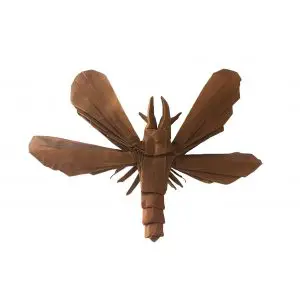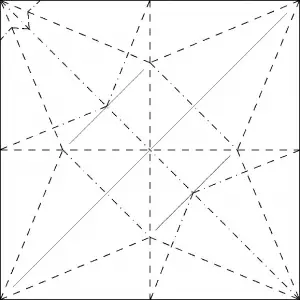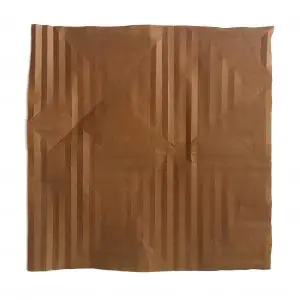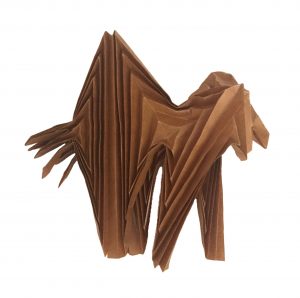
“Will you walk into my parlour?” said the spider to the fly;
“‘Tis the prettiest little parlour that ever you did spy.
The way into my parlour is up a winding stair,
And I have many pretty things to show when you are there.”
“O no, no,” said the little fly, “To ask me is in vain,
For who goes up your winding stair can ne’er come down again.”
The Spider and the Fly, Mary Howitt
Origami and insects
I’m not a great fan of origami insects. I know that’s bordering on heresy in origami circles and a lot of people that do origami absolutely love them. Robert Lang has created some incredibly detailed beetle designs. It’s just not a subject that appeals to me.
Note: This post contains affiliate links. Please see disclosure for more information.
There are many other fascinating, challenging, and stunningly beautiful models out there to fold. I made this one for the same reason that I suspect most people fold origami insects – for the technical challenge. Insects tend to be frail looking things with long, spindly, delicate legs, sometimes with wings and/or mandibles. Making a realistic looking origami insect out of a single sheet of paper is hard.
In the 1990s origami went through a period that became known as The Bug Wars as origami designers competed informally to design ever more complex and realistic insects, bugs, spiders and scorpions and brought them along to the next origami convention. This probably drove origami forward quite dramatically as people discovered new design techniques and modern complex origami probably owes quite a lot to the Bug Wars. It also means that there are huge numbers of origami insect designs out there for those people that like that sort of thing.
About the Origami Dobsonfly
I’m guessing Brian Chan does like origami insects because he designed this one. I’d never heard of a Dobsonfly before I came across this model. We don’t have them in the UK. Apparently they are found in the Americas, Asia and Africa. They are among the largest of their family of insect, and adult Dobsonflies can grow to have a wingspan of 180mm! So it says on Wikipedia.
Folding the Origami Dobsonfly
Part of the challenge of folding Chan’s origami Dobsonfly design is that there are no instructions – only a crease pattern. A crease pattern (often abbreviated online to ‘CP’) is exactly what it sounds like – a picture showing where the creases go on an unfolded piece of paper. In theory, you can fold all the creases marked on the CP and then collapse it down into the model. In practice, it’s not that simple.
A crease pattern often only shows the folds necessary to produce the base for the design, and there can be quite a lot of folding and shaping needed to get from the base to the finished model. The picture shows the crease pattern for a traditional Flapping Bird. Also, the crease pattern doesn’t show which folds to do in what order to make the base. It can be a case of trial and error, experience of what works and recognising common parts of the CP, or ‘put all the creases in and then try and collapse them all at the same time’.
There was a discussion about this model on the Origami Forum some time ago and the origami Dobsonfly was recommended as one of the best for learning how to fold from crease patterns. As the user Origami_8 said “It’s really simple it only looks difficult. First you divide the paper into fifths and divide those fifths into eights again. So you have an 40 by 40 grid (be sure it is valley-mountain-valley-…). Insert the diagonals, collapse everything into a base, form out the wings and thin out the legs. That’s all. Surely it costs some time, but you really don’t have to figure out something on your own, as soon as the model is collapsed into a base, you see how to finish it”.
I agree with her assessment. At first glance, it looks fiendishly difficult, but once you’ve put the creases in and start folding them, it’s pretty clear how the base has to collapse, When you’ve folded the base, you can easily see how to finish it off.
The origami Dobsonfly needs a paper that is thin enough to cope with multiple layers, pleating the tail and thinning the legs and holds a crease well. Tissue foil sold by origami-shop.com is ideal. Use a reasonably large sheet. The one in the picture above was made from a 30cm x 30cm (12in x 12in) square and produced a model that is 13cm (about 5in) long and has a wingspan of 15cm (6in).
I wouldn’t recommend using a piece of paper much smaller than this. It’s difficult to say how long it takes to fold this model as that depends on how quickly you can fold a 40×40 grid and collapse the base, but I’d allow at least an hour and a half. Fold the grid as accurately as you can. This will avoid a lot of disappointment later when you’ve finished the base and realise that your folds don’t line up.
Having folded the origami Dobsonfly, I was surprised how insect-like the final result is. Just like a real insect, the model looks incredibly detailed and feels very robust, yet extremely fragile at the same time. I have to say I’m impressed. I wouldn’t go so far as to say I like origami insects, but I’m not as dismissive as I was. I’ve got a copy of Origami Insects and their kin by Robert Lang on my bookshelf. Maybe I’ll dust that off and give some of them a go.
Origami Dobsonfly Diagrams
As I said, there aren’t any. Just a crease pattern. You can download a copy of the CP from Brian Chan’s website.
If you still don’t like the idea of folding from the CP, Goncalo Chambel has a video showing how to make the origami Dobsonfly with the permission of Brian Chan. It’s available on his YouTube Channel. You could follow that but why not take on the challenge of folding from the Crease Pattern?
Get Involved
I’d love to hear your views on this. Feel free to let me know what you think in the comments below, or you find can me on Instagram or Twitter. Check out my Pinterest boards too!
Sign up for my origami newsletter here and get our free Origami eBook.
Disclosure: This post contains affiliate links. This means we will receive a small commission for some purchases made using links in our blog with no additional cost to you. Please be assured we would not promote any product unless we believe that our readers will also benefit. The commission does not influence the editorial content of this site.
Origami Expressions is a participant in the Amazon Services LLC Associates Program, an affiliate advertising program designed to provide a means for sites to earn advertising fees by advertising and linking to amazon.com, amazon.co.uk, amazon.ca. Amazon and the Amazon logo are trademarks of Amazon.com, Inc. or its affiliates.




Outstanding Russell! I really appreciated hearing about the history of the design and use of CP. I’ll watch the video just to see how the insect is folded. Maybe one day, when I am more experienced, I’ll give it a try.
Thanks Claudia, glad you liked it. Watching the video is a good idea – you can get an idea of the relationship between the crease pattern and the completed design. You’ll get to folding from CPs before you know it!